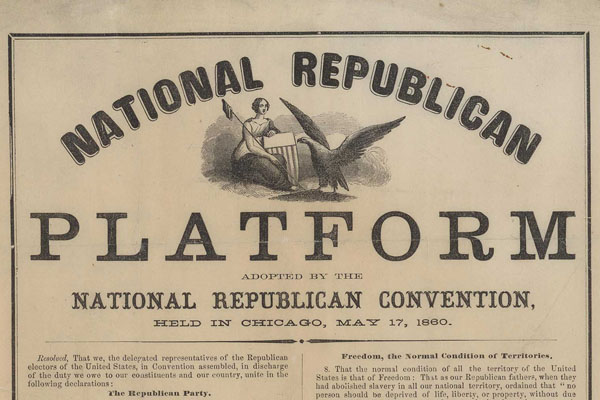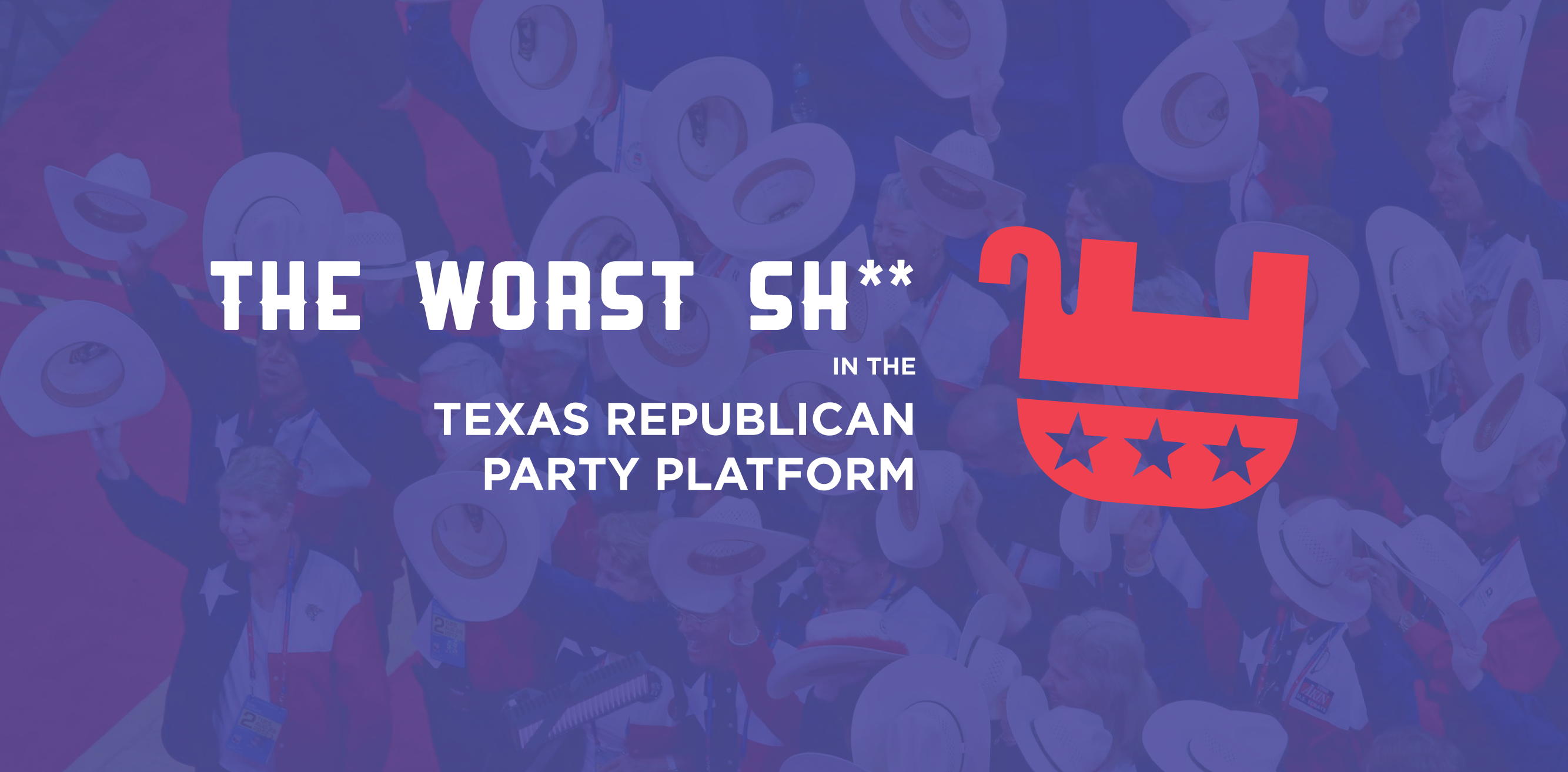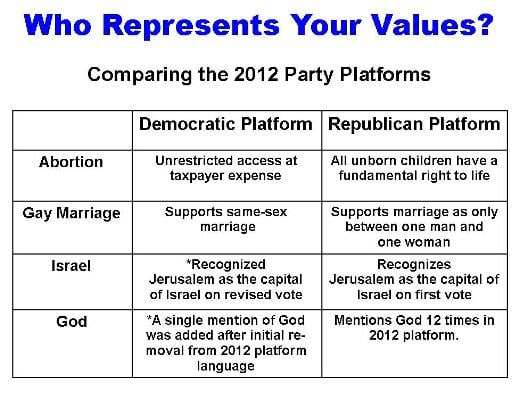American political parties are organized on a national, state, and local basis. Every four years, the parties hold a national convention to nominate a presidential and vice presidential candidate. They also meet to approve a party platform of issues and positions upon which the candidates will run. A party platform is a set of principles, goals, and strategies designed to address pressing political issues.
Each party's platform is broken down into "planks," or declarations that speak to each specific issue. Since 1980, a "gender gap" has seen stronger support for the Republican Party among men than among women. Unmarried and divorced women were far more likely to vote for Democrat John Kerry than for Republican George W. Bush in the 2004 presidential election.
In 2006 House races, 43% of women voted Republican while 47% of men did so. In the 2010 midterms, the "gender gap" was reduced, with women supporting Republican and Democratic candidates equally (49%–49%). Exit polls from the 2012 elections revealed a continued weakness among unmarried women for the GOP, a large and growing portion of the electorate. Although women supported Obama over Mitt Romney by a margin of 55–44% in 2012, Romney prevailed amongst married women, 53–46%. According to a December 2019 study, "white women are the only group of female voters who support Republican Party candidates for president. They have done so by a majority in all but 2 of the last 18 elections". With the inauguration of Bush as president, the Republican Party remained fairly cohesive for much of the 2000s as both strong economic libertarians and social conservatives opposed the Democrats, whom they saw as the party of bloated, secular, and liberal government.
Survey groups such as the Pew Research Center found that social conservatives and free market advocates remained the other two main groups within the party's coalition of support, with all three being roughly equal in number. However, libertarians and libertarian-leaning conservatives increasingly found fault with what they saw as Republicans' restricting of vital civil liberties while corporate welfare and the national debt hiked considerably under Bush's tenure. In contrast, some social conservatives expressed dissatisfaction with the party's support for economic policies that conflicted with their moral values. After 1912, the Republican Party began to undergo an ideological shift to the right.
Following the Civil Rights Act of 1964 and the Voting Rights Act of 1965, the party's core base shifted, with southern states becoming more reliably Republican in presidential politics. After the Supreme Court's 1973 decision in Roe v. Wade, the Republican Party opposed abortion in its party platform and grew its support among evangelicals. Its 21st-century ideology is American conservatism, which incorporates both social conservatism and fiscal conservatism.
The GOP supports lower taxes, free-market capitalism, restrictions on immigration, increased military spending, gun rights, restrictions on abortion, deregulation, and restrictions on labor unions. After the 2012 election, Senator John McCain, who is anti-abortion, advised his fellow Republicans to "leave the issue alone." He warned against going beyond stating one's anti-abortion belief and actions could hurt the Republican party with women voters and young voters. Like Bush I & II, Dole, Reagan, and Ford, McCain promised conservative constructionist judges but again stated he would not use abortion as a litmus test. Mitt Romney as governor of Massachusetts was firmly pro-abortion rights but he became anti-abortion running for president in 2012 and stated the same thing about conservative judges but not using abortion as a litmus test.
In 2016, though Donald Trump abruptly shifted his position on abortion. For decades as a Democrat and independent he was firmly pro-abortion rights, but by at least 2011 , Trump was claiming to be anti-abortion. Unlike the previous candidates, Trump made a promise during his debate with Hillary to appoint "pro life judges" to the US Supreme Court as well as to lower courts. He later had to take that statement back saying he was not even allowed to ask a judge what his personal position on abortion or any other issue was. He still affirmed he would appoint judges that interpret the law not make law and on abortion they would hopefully see it as a constitutional issue turning the rulings over to the states and overturning Roe. Trump did state he believed in exceptions of rape and incest as well as to saving the life of the mother on his anti abortion stance.
As of 2020, Republican candidates had lost the popular vote in seven out of the last eight presidential elections. Since 1992, the only time they won the popular vote in a presidential election is the 2004 United States presidential election. Demographers have pointed to the steady decline of its core base of older, rural white men.
However, Donald Trump managed to increase nonwhite support to 26% of his total votes in the 2020 election — the highest percentage for a GOP presidential candidate since 1960. Republicans have been winning under 15% of the black vote in recent national elections . The party abolished chattel slavery under Abraham Lincoln, defeated the Slave Power, and gave blacks the legal right to vote during Reconstruction in the late 1860s.
Until the New Deal of the 1930s, blacks supported the Republican Party by large margins. Black delegates were a sizable share of southern delegates to the national Republican convention from Reconstruction until the start of the 20th century when their share began to decline. Black voters began shifting away from the Republican Party after the close of Reconstruction through the early 20th century, with the rise of the southern-Republican lily-white movement.
Blacks shifted in large margins to the Democratic Party in the 1930s, when major Democratic figures such as Eleanor Roosevelt began to support civil rights and the New Deal offered them employment opportunities. They became one of the core components of the New Deal coalition. In the South, after the Voting Rights Act to prohibit racial discrimination in elections was passed by a bipartisan coalition in 1965, blacks were able to vote again and ever since have formed a significant portion (20–50%) of the Democratic vote in that region. Republicans are divided on how to confront illegal immigration between a platform that allows for migrant workers and a path to citizenship for undocumented immigrants , versus a position focused on securing the border and deporting illegal immigrants . In 2006, the White House supported and Republican-led Senate passed comprehensive immigration reform that would eventually allow millions of illegal immigrants to become citizens, but the House did not advance the bill.
After the defeat in the 2012 presidential election, particularly among Latinos, several Republicans advocated a friendlier approach to immigrants. However, in 2016 the field of candidates took a sharp position against illegal immigration, with leading candidate Donald Trump proposing building a wall along the southern border. Proposals calling for immigration reform with a path to citizenship for undocumented immigrants have attracted broad Republican support in some[which? In a 2013 poll, 60% of Republicans supported the pathway concept. Democrat and Republican Party elites and elected officials became more divided on the issue of abortion in the 1980s. Still, Ronald Reagan ran and won the election in 1980, stating he was against all abortions except for saving the life of the mother.
He firmly supported Roe v. Wade being overturned and a constitutional amendment banning abortion. Robert Dole, who ran in the primary for president in 1980, also firmly opposed abortion. George H.W. Bush, who also ran in the primary, was firmly pro-abortion rights. Bush wound up being Reagan's vice presidential running mate and after that, he distanced himself from that issue. It was not until after Republicans in Congress started consistently voting against abortion in the 1980s that polls showed Republican opposition to abortion.
Early abortion laws only allowed the procedure when the woman's life was in danger. At this time many Republicans and Democrats as well were for less strict abortion laws. Between 1974 and 1978, studies showed that political ideology had a very weak correlation with support for abortion rights. The correlation between political party identification and support for abortion rights was even weaker.
Mary Louise Smith, the chairwoman of the Republican National Committee from 1974 to 1977, was pro-abortion rights. Justice Blackmun wrote the Supreme Courts decision on Roe v. Wade. Blackmun had been conservative Justice appointed by President Nixon, who came out against abortion.
After Roe v. Wade, though, Blackmun gradually evolved into a liberal. Some say this issue was the symbolic move of Blackmun to becoming a liberal. Not all Republicans support abortion restrictions and the human life amendment. Though anti-abortion planks have been part of the party platform since 1976., before 1988 there was little difference between Republicans and other voters regarding abortion, and in 2015, 40 percent of Republicans supported legal abortion. Despite their divergence from the party platform, pro-abortion rights Republicans are unlikely to switch parties. Pro-abortion rights ideology has been present in the Republican Party since before the Roe v. Wade decision in 1973, and the pro-abortion rights ideology is still present today.
No person may seek election as a delegate or alternate in more than one District during one election cycle. In addition, the delegates and alternates must have voted or affiliated with the Republican Party in the last general election or intend to vote or affiliate with the Republican Party in the next general election. These platforms are developed by individual committees of each party during a presidential election year and are voted on during quadrennial party conventions. They are non-binding but do serve as roadmaps for not only presidential candidates to reference, but for other candidates and officials seeking elected office under each of the respective parties. In anticipation of the upcoming presidential election in November, the Republican and Democratic National Committees released their platforms.
These platforms provide an overview of values, policies, positions, and principles on various domestic and foreign issues deemed most important to the two political parties. Throughout most of American history, the United States has had two major parties. Today's Democratic Party can trace its origins to Jefferson's old party. Today's Republican Party can trace its origins to the election of 1854.
Some of these parties were formed to promote a particular cause, such as the Prohibition Party or the Equal Rights party, which demanded the vote for women. Other third parties, such as the Populists and the Greenbackers, arose for a short period around economic issues. Some third parties, such as the Progressives and the Dixiecrats, splintered off from the Republican and Democratic parties. Some parties have developed around a certain leader, such as George Wallace's American Independent Party or Ross Perot's Reform Party.Third parties have never received high percentages of votes at election time, but they still serve important functions in the American political system.
They also give those promoting reform a chance to air their ideas. For example, many of the ideas of the Progressives eventually were adopted by the major parties. Each of these states passed a resolution outlining the justifications for their action; as in the case of Mississippi, these tended to emphasize the centrality of slavery as an institution to the Southern way of life and to paint Northern policies as not only a political but an existential threat. Virtually all restrictions on voting have in recent years been implemented by Republicans.
Republicans, mainly at the state level, argue that the restrictions are vital to prevent voter fraud, claiming that voter fraud is an underestimated issue in elections. Polling has found majority support for early voting, automatic voter registration and voter ID laws among the general population. Research has indicated that voter fraud is very uncommon, and civil and voting rights organizations often accuse Republicans of enacting restrictions to influence elections in the party's favor. Many laws or regulations restricting voting enacted by Republicans have been successfully challenged in court, with court rulings striking down such regulations and accusing Republicans of establishing them with partisan purpose.
However, public opinion on this issue within the party has been changing. Following his election as president in 2016, Donald Trump stated that he had no objection to same-sex marriage or to the Supreme Court decision in Obergefell v. Hodges, but at the same time promised to appoint a Supreme Court justice to roll back the constitutional right. In office, Trump was the first sitting Republican president to recognize LGBT Pride Month. Conversely, the Trump administration banned transgender individuals from service in the United States military and rolled back other protections for transgender people which had been enacted during the previous Democratic presidency.
Republicans have historically opposed same-sex marriage, while being divided on civil unions and domestic partnerships. During the 2004 election, George W. Bush campaigned prominently on a constitutional amendment to prohibit same-sex marriage; many believe it helped George W. Bush win re-election in 2004. In both 2004 and 2006, President Bush, Senate Majority Leader Bill Frist, and House Majority Leader John Boehner promoted the Federal Marriage Amendment, a proposed constitutional amendment which would legally restrict the definition of marriage to heterosexual couples. In both attempts, the amendment failed to secure enough votes to invoke cloture and thus ultimately was never passed. As more states legalized same-sex marriage in the 2010s, Republicans increasingly supported allowing each state to decide its own marriage policy.
As of 2014, most state GOP platforms expressed opposition to same-sex marriage. The 2016 GOP Platform defined marriage as "natural marriage, the union of one man and one woman," and condemned the Supreme Court's ruling legalizing same-sex marriages. The 2020 platform retained the 2016 language against same-sex marriage. The 1896 realignment cemented the Republicans as the party of big businesses while Theodore Roosevelt added more small business support by his embrace of trust busting.
He handpicked his successor William Howard Taft in 1908, but they became enemies as the party split down the middle. Taft defeated Roosevelt for the 1912 nomination and Roosevelt ran on the ticket of his new Progressive ("Bull Moose") Party. He called for social reforms, many of which were later championed by New Deal Democrats in the 1930s. He lost and when most of his supporters returned to the GOP they found they did not agree with the new conservative economic thinking, leading to an ideological shift to the right in the Republican Party. The Republicans returned to the White House throughout the 1920s, running on platforms of normalcy, business-oriented efficiency and high tariffs. The national party platform avoided mention of prohibition, instead issuing a vague commitment to law and order.
Of all the major conservative parties in the democratic world, the Republican Party stands alone in its denial of the legitimacy of climate science. Indeed, the Republican Party stands alone in its conviction that no national or international response to climate change is needed. To the extent that the party is divided on the issue, the gap separates candidates who openly dismiss climate science as a hoax, and those who, shying away from the political risks of blatant ignorance, instead couch their stance in the alleged impossibility of international action. The platform of the Republican Party of the United States is generally based on American conservatism, contrasting with the modern liberalism of the Democratic Party. The positions of the Republican Party have evolved over time. Currently, the party's fiscal conservatism includes support for lower taxes, free market capitalism, deregulation of corporations, and restrictions on labor unions.
The party's social conservatism includes support for gun rights and other traditional values, often with a Christian foundation, including restrictions on abortion. In foreign policy, Republicans usually favor increased military spending and unilateral action. Other Republican positions include restrictions on immigration, opposition to drug legalization, and support for school choice. Healthcare—and specifically public health—will be one of the top issues people will vote on in the November elections. Although the platforms offer nothing more than a list of priorities approved by each of the parties, they do offer insight into the most important issues of each party.
In addition, they also provide an avenue to hold elected officials accountable during their service in office. After reading about the origins and functions of political parties, students create a party platform to address political issues that are likely to arise during a national election. The official business of the convention is taking place in Charlotte, N.C., beginning Monday morning, with delegates voting to select the party's nominee for November's presidential election. Trump won 2,395 total delegates in the GOP primaries, needing just 1,276 to secure the party's nomination. I have not always agreed with Biden, and it's unlikely I will always agree with him if he is elected president.
But when disagreements do occur, I will have returned to the ranks of the loyal opposition and will be able to express my objections and prescriptions by appealing to the deeply held principles that have guided him throughout his career in public service. Those differences will likely be due to conflicting views over policy, and at least the Democrats put out a party platform of policies to debate. While scholars agree that a racial backlash played a central role in the racial realignment of the two parties, there is a dispute as to the extent in which the racial realignment was a top-driven elite process or a bottom-up process. The "Southern Strategy" refers primarily to "top-down" narratives of the political realignment of the South which suggest that Republican leaders consciously appealed to many white southerners' racial grievances in order to gain their support. This top-down narrative of the Southern Strategy is generally believed to be the primary force that transformed Southern politics following the civil rights era.
Scholar Matthew Lassiter argues that "demographic change played a more important role than racial demagoguery in the emergence of a two-party system in the American South". During his presidency, President Gerald R. Ford took a moderately conservative stance on abortion, despite First Lady Betty Ford's urges for him to take a liberal stance on the issue. Ford believed abortions should be allowed in certain circumstances, such as rape and incest, and opposed a human life amendment to the Constitution. After winning the primary, Ford stated he was also unconditionally anti-abortion and fully supported the Republican platform in 1976. Still, Ford later stated that he was pro-abortion rights after he had left office and Betty Ford was supportive of the decision made by the court in Roe v. Wade. Notice to the voting body shall be provided at least 15 days in advance of the State Committee Meeting at which the letter of support may be granted.





























No comments:
Post a Comment
Note: Only a member of this blog may post a comment.